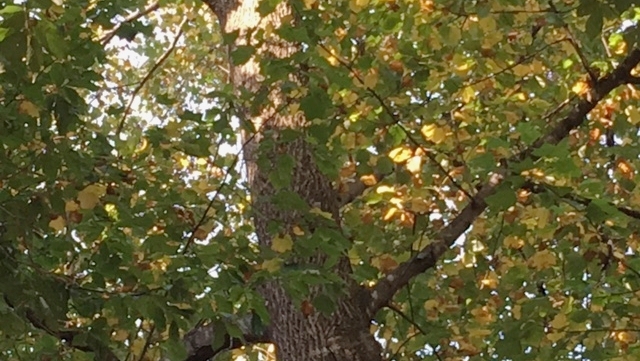Summer Leaf Yellowing and Drop on Trees
The ground looks like fall, but this is July
You may be a bit concerned if your yard suddenly looks like fall has come early, with tree leaves turning yellow and dropping like crazy. In most cases it’s not something to worry about as there are a few common reasons that trees drop leaves in summer.
The most benign reason is simply adaptation to conditions. Trees do react to the environment and adapt their growth accordingly.
Trees grow leaves in spring based on the conditions at the time. Locally, spring 2017 was (very) wet and temperatures were (relatively) moderate, and trees’ response was “Pleasant temperatures and plenty of water. Perfect conditions! Grow leaves, lots and lots of leaves!”
Then, our almost-daily rain—that’s what it felt like at least—stopped at almost exactly the same time as our normal summer heat hit. Now the trees’ response is “Yikes, hot and dry, I’ve got too many leaves losing too much water! Dump some quick!”
Tulip poplar with leaves yellowing due to dry conditions. These leaves will drop soon. It's not technically a drought, but the tree is reacting like it's in one.
Boom-you get October in July, break out the rakes. Leaves dropped for this reason will be yellow to tan with few if any leaf spots on them. Ten to twenty percent or more leaf drop is possible, but unless a tree is heavily defoliated for several years in a row, this normal adjustment to heat and dry weather doesn’t affect the health of the tree.
Of course every tree doesn’t react this way, as some tree species are less tolerant of hot humid weather and react more quickly. Even trees of the same species planted in different conditions can react differently. Newly planted (within a year or two) trees are particularly prone to drop as they haven't formed as many roots as mature trees. Remember to water your new trees regularly for at least the first year and during dry spells indefinitely to minimize leaf drop.
This young cherry has been in the ground for a year, and has fewer roots to find water than the mature cherry in the next picture. It's lost 90% of it's leaves.
An older cherry-it has still dropped leaves, but proportionately fewer.
Another reason for leaf drop is disease, and the same ‘wet spring followed by hot summer’ scenario is also a perfect set-up for leaf diseases. In this case the leaves will have significant spots or brown areas.
It’s important to rake up affected leaves and dispose of them to reduce the chance of spreading disease in following years, but again, unless the tree is defoliated repeatedly, it’s not too much of a concern. And just as trees have varying reactions to hot and dry conditions, some trees are more susceptible to disease.
(While technically you could spray diseased trees, that is better done 1) before the disease takes hold, particularly on frequently affected trees and 2) on smaller trees, as spraying large trees is often not practical from a cost/benefit standpoint.)
You can (and should) water your trees in dry periods to reduce stress, but don’t fertilize until fall-trees know how to deal with the conditions and you don’t want to encourage leaves that can’t be supported.
When should you be concerned with early leaf drop? If twigs and branches are dying you may have a more serious problem. You can tell dead twigs from live twigs because they are brittle and snap when bent, as opposed to live twigs which should still be plump, be supple and bendable. You should also be concerned if your tree defoliated heavily (over 50% leaf loss) for two years in a row, or if there is evidence of insect infestation causing drop.



